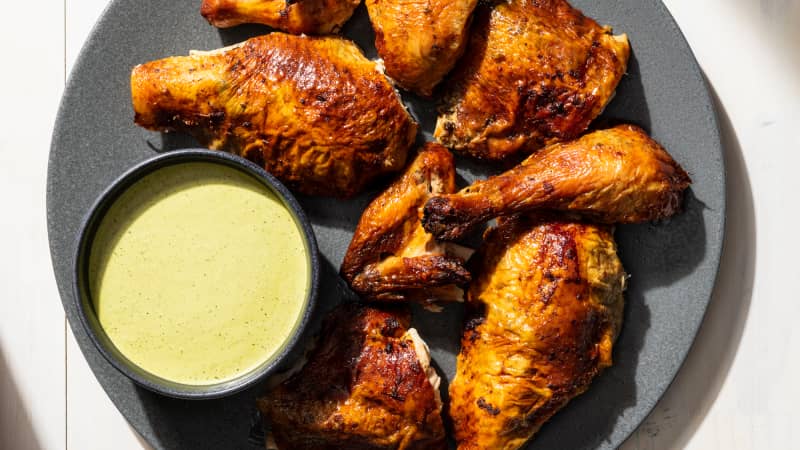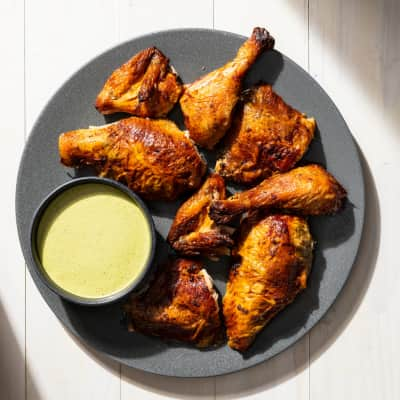The Asociación Peruana de Avicultura (Peruvian Association of Poultry Farming) estimates that more than 155 million pollos a la brasa are consumed annually in Peru. Maestros polleros, or poultry masters, grill-roast the extraordinarily popular birds on rotisseries that spin lazily over crackling wood fires (“brasa” means “ember”) to produce meat that’s encased in tawny, paper-thin skin and dripping with juices. Served with a pile of crispy french fries, a simple green salad, and an array of peppy ají (chile) sauces, the flavor-packed, satisfying dish has been central to the country’s dining scene for decades.
This Grilled Chicken Is So Good, It Has Its Own Holiday
Published May 17, 2022.

It’s been given its own national holiday, Día del Pollo a la Brasa, on the third Sunday of every July.
Sign up for the Cook's Insider newsletter
The latest recipes, tips, and tricks, plus behind-the-scenes stories from the Cook's Illustrated team.
It all began in the 1940s when Swiss migrant Roger Schuler needed a way to rescue his bankrupt poultry farm on the outskirts of Lima, Peru. To attract customers, he set up a roadside stand peddling all-you-can-eat chicken that he’d skewered on a thick iron spit rod and roasted over an algarrobina (black carob) fire. The birds were such a hit among Limeños that Schuler recruited Swiss metal worker Franz Ulrich to increase production by engineering a six-spit rotisserie. In 1950, the pair opened a pollería called Granja Azul, and customers flocked to it.
Since then, pollerías have sprung up on nearly every block in most Peruvian cities, providing a go-to option for affordable takeout or dining in. Home cooks prepare these grill-roasted chickens, too. So beloved is the chicken that it’s been given its own national holiday, Día del Pollo a la Brasa, celebrated on the third Sunday of every July.
To learn more about this iconic dish, I called Peruvian-born chef Jose Duarte, owner of Tambo 22 restaurant near Boston. He recalled Peru’s family-friendly take-out routine: “Instead of cooking dinner one night, you just go and buy one chicken with french fries, and they sell you the sauces in little bags tied in knots . . . and a big bottle of soda.”
Vertical Organization
Duarte feels that a high-quality bird needs only salt, pepper, and licks from wood-fired flames to taste great, but it’s now common for Peruvian cooks to ratchet up the flavor via a marinade or wet rub. I came to prefer a beer-based marinade, which seeped into the flesh of the chicken when I loosened the skin covering its breast and leg quarters. Along with half a can of malty beer, I incorporated ingredients that are often used in pollerías today: soy sauce for salinity; lime juice and mustard for brightness; and garlic, dried thyme, black pepper, and cumin for earthy, savory depth.
Since I didn’t have a rotisserie to rotate the chicken horizontally, I used the half-empty beer can to prop it up vertically, sliding the cavity onto the vessel to create a sort of tripod with the drumsticks. I positioned the propped-up bird in the center of a kettle grill outfitted with a split fire made by dumping piles of hot coals onto either side of a disposable aluminum pan and nestling a packet of wood chips on one side.
The Next Best Thing to a Rotisserie

To mimic a wood-fired rotisserie, prop the bird up on a beer can and flank it with smoldering charcoal, placing a packet of wood chips on one side. Rotate the bird 90 degrees every 15 minutes for about five turns. The resulting chicken will be almost indistinguishable from the spit-roasted kind: succulent; imbued with the sweetness of wood smoke; and encased in evenly browned, well-rendered skin.
The key was to rotate the chicken a quarter turn every 15 minutes so that at any given moment, two sides would be blasted with heat while the other two sides got a reprieve. While not the constant movement of a rotisserie, about five turns produced remarkably succulent, smoky meat packaged in well‑rendered, uniformly mahogany skin.
Two Pastes That Make the Sauces

Ají amarillo (yellow chile) and huacatay (an herb that’s often called black mint) add spark and depth to many of the sauces that accompany pollo a la brasa. Vibrant ají amarillo gives off fruity, habanero-like vibes with moderate heat. Huacatay, on the other hand, is evocative of vegetables and freshly cut grass with menthol undertones. Both can be hard to find fresh in the United States and are typically sold as jarred pastes.
Awesome Sauces
Zippy ají sauces are mandatory with pollo a la brasa, but they’re not just for the chicken: Peruvians also drizzle them onto the salad and fries that share the plate. There are lots of local variations, but most are mayonnaise-based, and all are packed with gutsy seasonings such as garlic, lime, and herbs. After whipping up yellow (ají amarillo) and green (jalapeño) versions—make both if you can swing it—I devoured pollo a la brasa, right in my own backyard.


